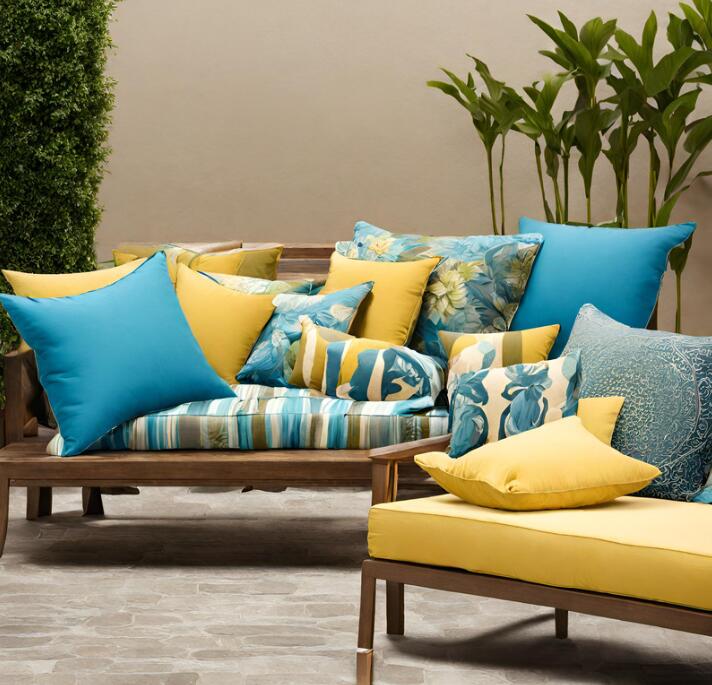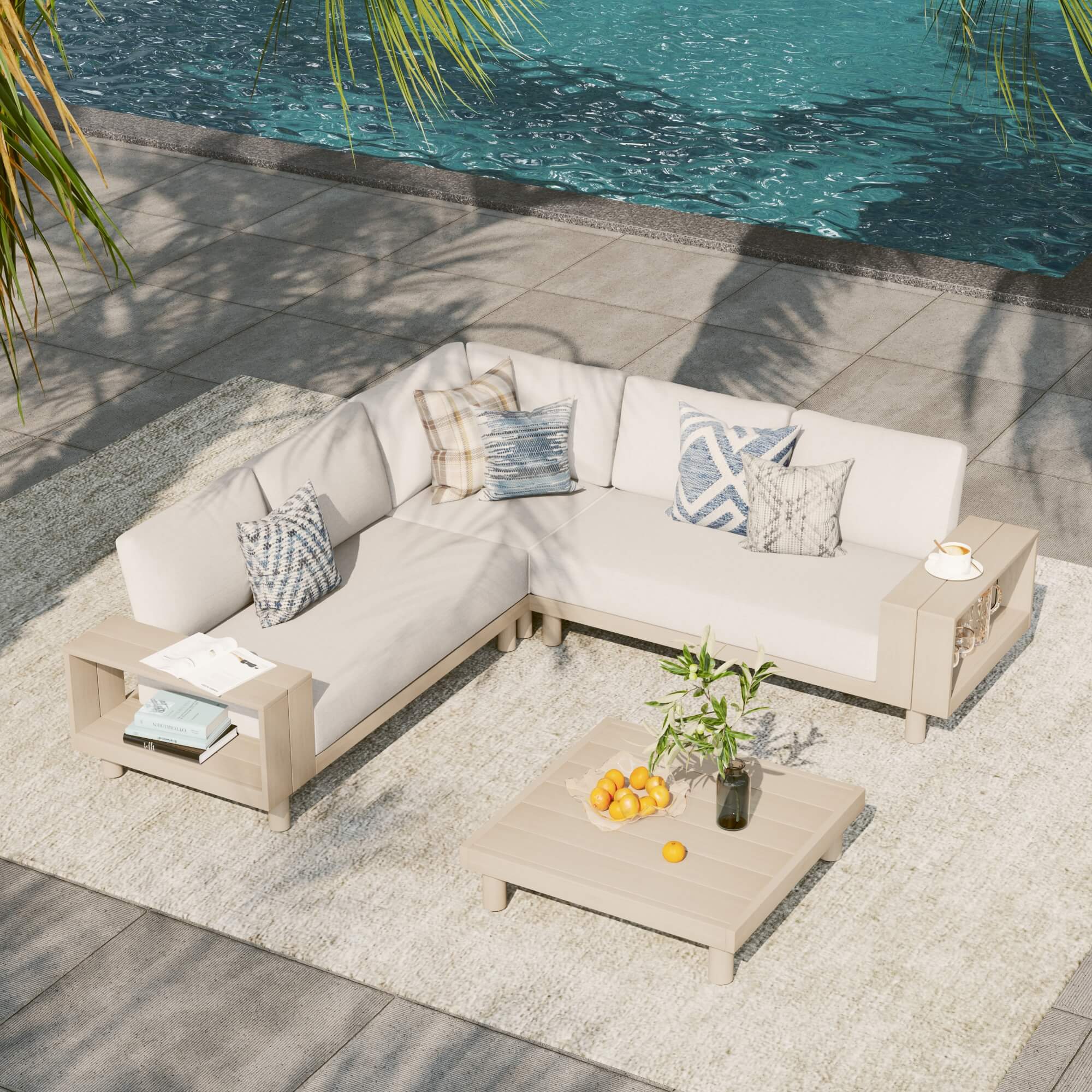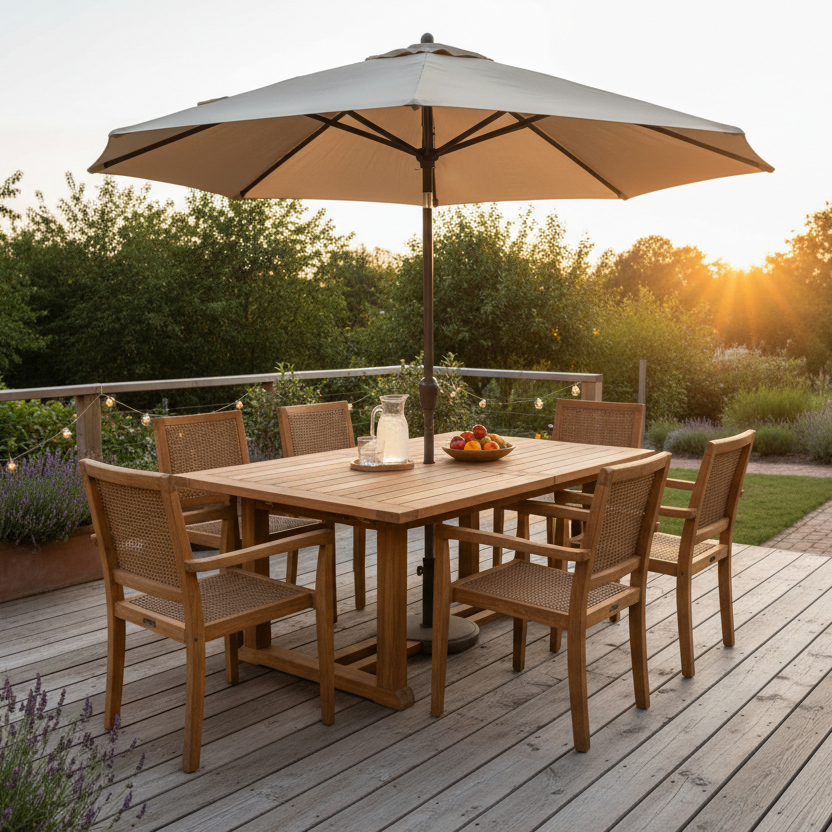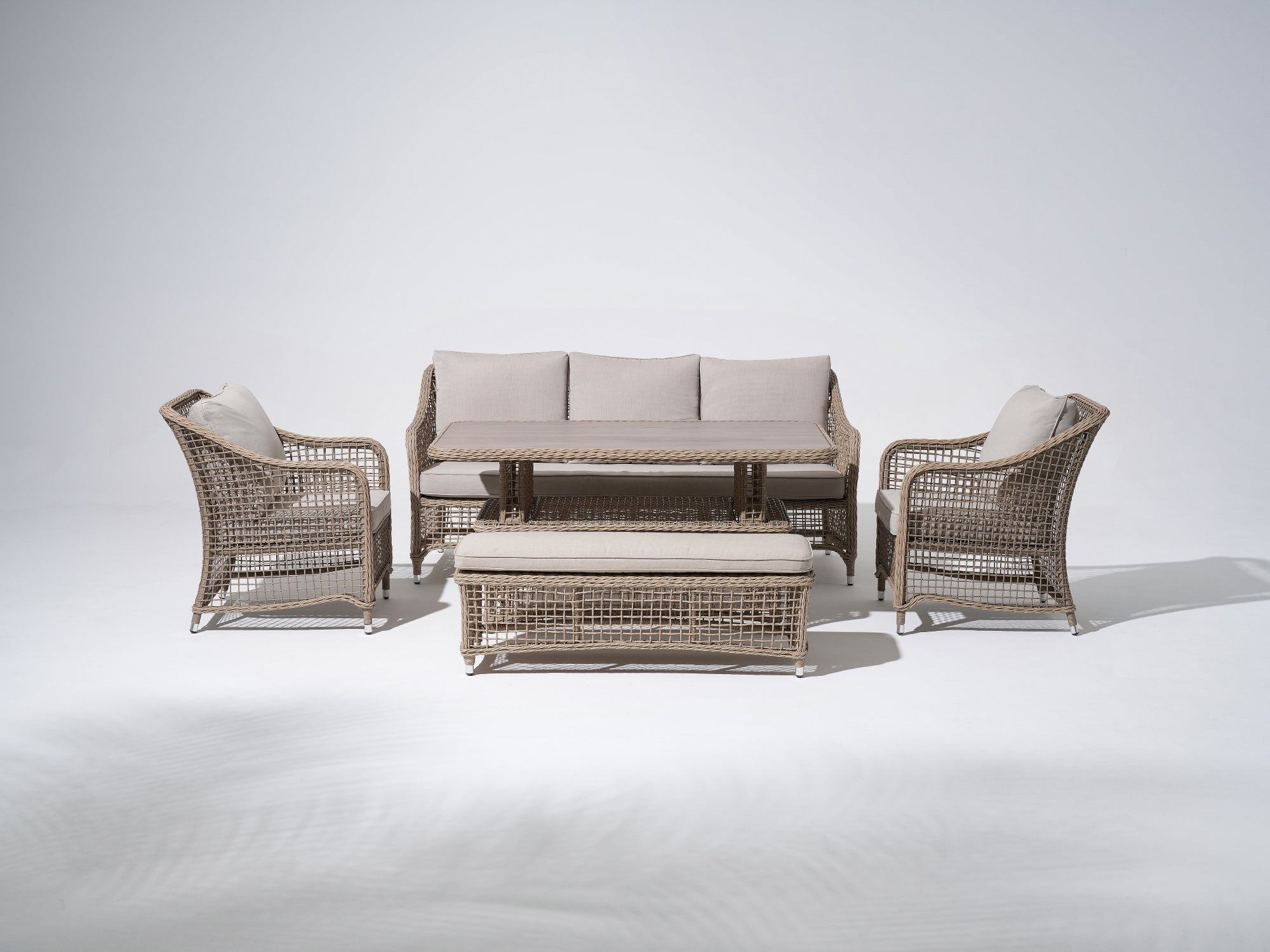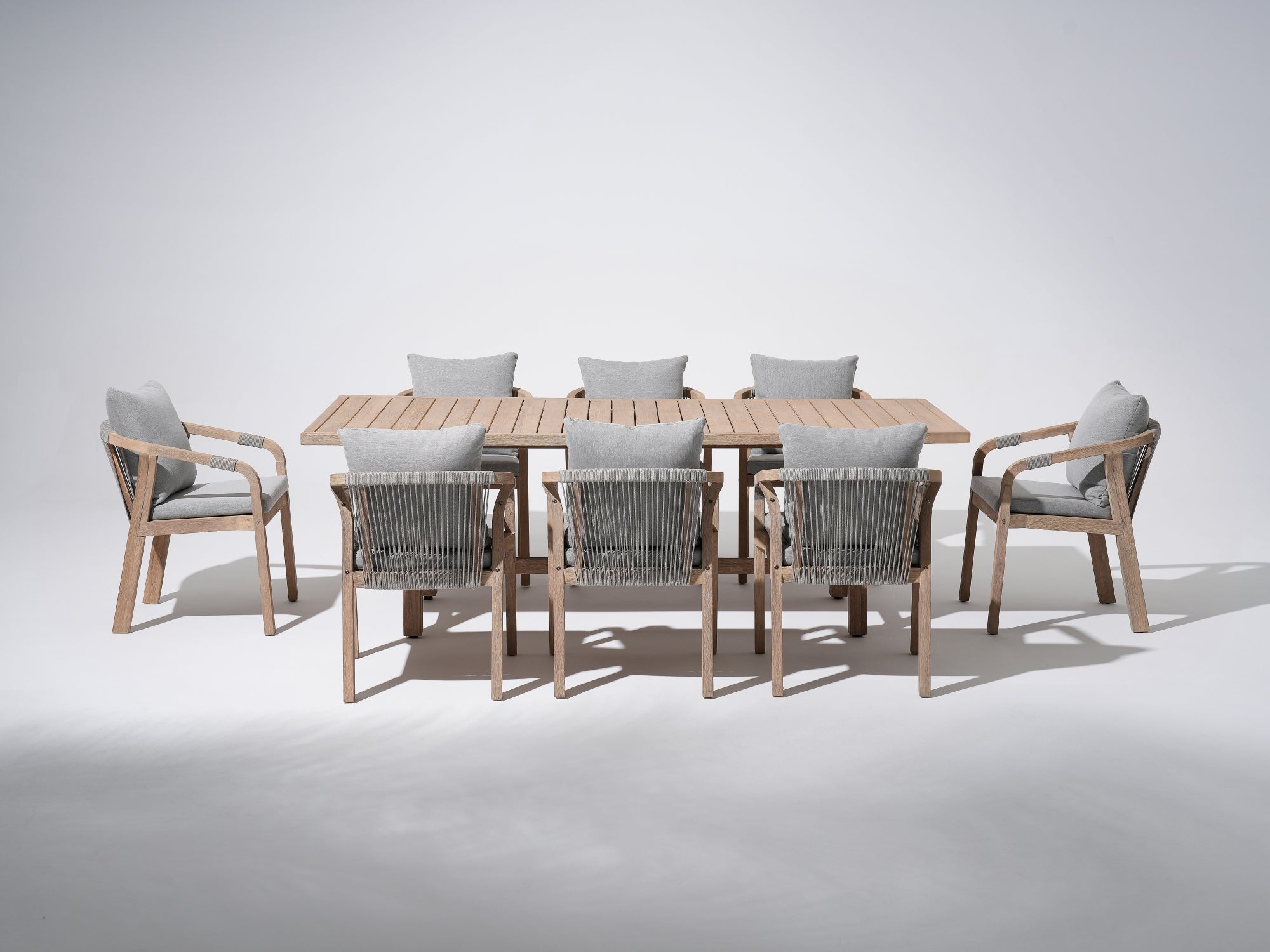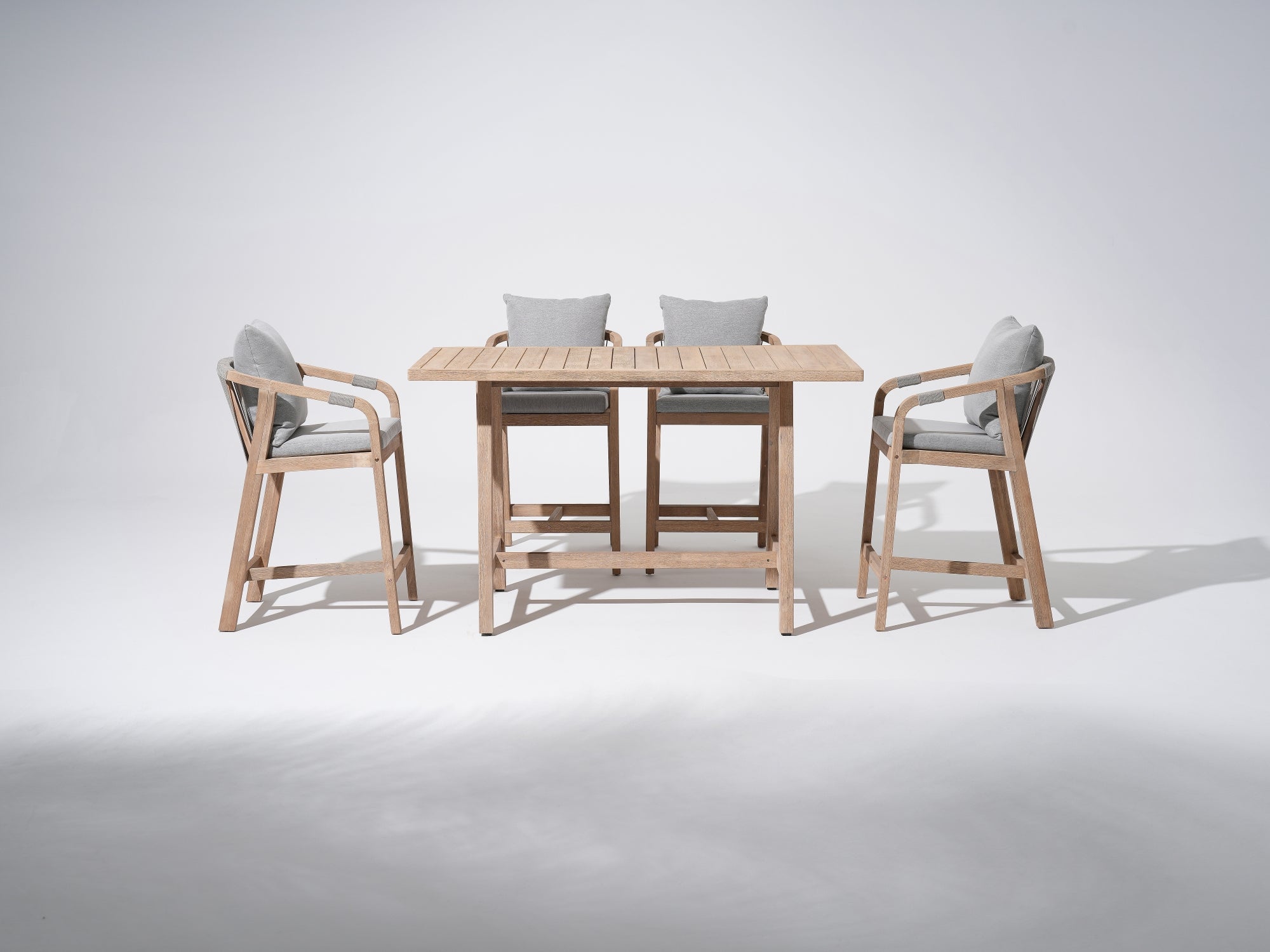Is it necessary to use cushions for outdoor furniture? The answer is yes, although the absence of cushions does not affect the use of outdoor furniture, choosing outdoor furniture with cushions is a great way to enhance the outdoor experience. Adding cushions not only provides extra comfort but also adds a touch of style and personality to your outdoor space. Whether you're lounging by the pool, catching up with friends, or just enjoying a moment of relaxation, the soft padding and support of the seat will make the difference.
Nowadays, outdoor furniture merchants will provide additional seat cushions and back cushions. However, some furniture merchants may use cheap or uncomfortable cushions to save costs, which requires us to replace them as needed. So how do you choose good outdoor cushions?

First, let’s understand the composition of outdoor cushions. Whether outdoor cushions are useful or not mainly depends on two parts: filling and fabric.
Fillings of Outdoor Cushions
1. Polyester Fiber
This is a popular choice for outdoor cushions due to its affordability, quick-drying nature, and resistance to mold and mildew. Polyester fiberfill is lightweight, retains its shape well, and is easy to clean. But over time, it may flatten or clump, reducing its plushness and support. It might also be less resilient compared to other options.
2. Foam
Outdoor foam is designed to withstand moisture and resist mold and mildew. Foam is a commonly used filling material for outdoor cushions due to its comfort, support, and durability. But foam is divided into several types. The most common types of outdoor cushion foam include:
- Open-Cell Foam: This type of foam is porous, allowing water to pass through quickly. It's ideal for outdoor use as it doesn't retain moisture, which helps prevent mold and mildew. Open-cell foam dries faster, making it suitable for areas exposed to rain or humidity.
- Closed-Cell Foam: Unlike open-cell foam, closed-cell foam has a more compact structure that prevents water absorption. It's resistant to moisture, making it suitable for areas where cushions might be exposed to rain or moisture frequently. Closed-cell foam tends to be more durable but might not provide the same level of breathability as open-cell foam.
- High-Density Foam: This type of foam is known for its durability and ability to offer excellent support. It retains its shape well and provides a comfortable seating experience. High-density foam is often used in outdoor cushions for its resilience against wear and tear.
- Quick-Dry Foam: Specifically engineered for outdoor use, quick-dry foam is designed to repel water and dry quickly. It's an ideal option for areas with high humidity or frequent exposure to rain. This type of foam prevents water retention, reducing the risk of mold and mildew.
Several factors contribute to determining the quality of foam used for outdoor cushions:
- Density: Foam density refers to the amount of material in a specific volume. Higher density foam tends to be more durable and supportive. For outdoor cushions, foam with a higher density is preferred as it better withstands frequent use and outdoor elements. It provides better comfort and retains its shape for a longer period.
- Cell Structure: Foam cell structure affects its breathability and water resistance. Open-cell foam allows air and water to pass through, aiding in quick drying and preventing moisture buildup, which is crucial for outdoor cushions. Closed-cell foam, on the other hand, offers better water resistance but might not be as breathable.
- Water Resistance: Quality outdoor foam should be water-resistant or quick-drying to withstand exposure to rain, humidity, and moisture. Foam designed for outdoor use is typically treated to repel water and resist mold and mildew growth.
- Mold and Mildew Resistance: The foam used in outdoor cushions should have properties that inhibit the growth of mold and mildew. This prevents unpleasant odors and extends the life of the cushions in damp or humid conditions.
- UV Resistance: Exposure to sunlight can cause fading and deterioration of foam over time. High-quality outdoor foam is often treated or manufactured with additives that make it more resistant to UV rays, reducing the risk of discoloration and degradation.
- Durability and Resilience: A high-quality outdoor foam should be resilient and able to maintain its shape and support even with frequent use. It should withstand compression and bouncing back to its original form without sagging or losing support.
- Manufacturing Standards and Certifications: Look for foam that meets industry standards and certifications for quality and durability. Certifications like CertiPUR-US or similar standards ensure that the foam is made without harmful chemicals and meets specific performance criteria.
The more well-known foam types include Polyurethane (PU) Foam and Memory Foam. Memory foam is a special type of polyurethane foam. Its structure is denser and it is more sensitive to temperature and weight. When pressure is applied, it slowly springs back and "remembers" the shape of the compression. This allows it to provide customized support and comfort based on the contours of the body. It can be more expensive than other options.
When purchasing outdoor cushions with foam filling, consider these factors to ensure you get high-quality cushions that can endure outdoor conditions and provide long-lasting comfort and support.
3. Dacron
Dacron is a polyester material commonly used as a wrap around foam cushions. It helps in preventing the growth of mold and mildew while providing a smooth surface and added resilience. Without proper maintenance, it might compress or flatten over time, affecting its plushness and support.
4. Acrylic Fiber
Resembling the softness of cotton, acrylic fiber is resistant to moisture, fading, and mildew. It's often used in outdoor cushions because of its durability and ability to retain its shape. Acrylic fiber may be more expensive compared to some other outdoor cushion materials. The production of acrylic fibers involves the use of petrochemicals, which raises environmental concerns. Some people prefer more sustainable and eco-friendly options for outdoor furnishings. Acrylic fibers may have a tendency to generate static electricity, and acrylic fibers may retain heat, which can be a consideration in hot climates.
5. Cottons
Some outdoor cushions use natural fillings like kapok, a natural fiber extracted from the seed pods of kapok trees, or cotton. While these materials may offer comfort, they might not be as weather-resistant as synthetic options.
Fabrics Of Outdoor Cushion Covers

Outdoor cushion covers are available in various fabrics, each offering unique characteristics suited for outdoor use. Here are some common fabric options for outdoor cushion covers:
1. Sunbrella®(acrylic fibers)
Sunbrella fabrics are made from acrylic fibers and are specifically engineered for outdoor use. These fabrics are renowned for their exceptional durability, fade resistance, water repellency, and easy maintenance. Sunbrella fabrics come in a wide range of colors and patterns, offering both style and performance.
2. Polyester
Polyester fabric is a popular choice for outdoor cushion covers due to its durability, resistance to fading, and ease of maintenance. It's known for its ability to withstand exposure to sunlight, moisture, and mildew. Polyester is often treated to be water-resistant or waterproof, making it suitable for outdoor environments.
3. Olefin (Polypropylene)
Olefin is a synthetic fiber known for its resistance to moisture, staining, and fading. It's often used in outdoor cushion covers due to its durability and ability to dry quickly. Olefin fabrics are also resistant to mold and mildew, making them suitable for outdoor applications.
4. Vinyl
Vinyl fabrics are waterproof and highly resistant to moisture, making them suitable for outdoor cushion covers in wet climates. They are easy to clean and maintain, offering good protection against spills and stains.
5. Canvas
Canvas fabrics, particularly those treated for outdoor use, are sturdy and durable. They are resistant to water and mildew and offer good protection against UV rays. Canvas covers can come in various weights and textures, providing options for different preferences.
When selecting outdoor cushion covers, consider the specific environmental conditions they will be exposed to, such as sunlight, rain, humidity, and temperature fluctuations. Sunbrella fabrics are a better choice, but may be more expensive.
-------------------------------
After understanding the filling and fabrics, we also need to consider the size and color of the cushions. In particular, the length and width of the seat cushion should not be too small as it will become loose, nor too large as it will not fit in and affect the appearance. It is best to choose cushions with fasteners.
Determine The Correct Size Cushion For Outdoor Furniture

1. Measure the Furniture: Begin by measuring the dimensions of the outdoor furniture where the cushions will be placed. Take accurate measurements of the seating area's length, width, and depth. For chairs, measure the seat width and depth. For benches or sofas, measure the seating area accordingly.
2. Consider Overhang: Decide whether you want the cushions to fit exactly within the frame of the furniture or if you prefer a bit of overhang for a more relaxed look. Overhanging cushions can provide added comfort and style.
3. Thickness of Cushions: Determine the desired thickness or depth of the cushions. Thicker cushions can provide more comfort but might not be suitable for all furniture types, so consider the depth of the seat and backrest.
4. Account for Back Cushions: If your outdoor furniture includes backrests that require cushions, measure the height and width of the backrests to ensure the back cushions will fit properly and provide adequate support.
5. Factor in Ties or Fasteners: Some outdoor cushions come with ties or fasteners to secure them to the furniture. Consider the presence of these ties and how they might affect the fit and placement of the cushions.
6. Customization Options: Consider custom-made cushions if your furniture has unique dimensions.
Choose The Right Color of Outdoor Cushions

Selecting the ideal color of outdoor cushions often revolves around the style and color scheme of your outdoor furniture. For vibrant or colorful outdoor furniture, consider choosing cushions in complementary or coordinating tones to accentuate the existing color palette. Bold furniture pieces might be complemented by neutral cushions, allowing the furniture itself to remain the focal point while adding a touch of sophistication. Alternatively, for more subdued or neutral-colored furniture, opt for cushions in brighter hues or patterns to introduce a pop of color and infuse energy into the outdoor space. Harmonizing the cushion colors with the overall style and color scheme of the outdoor furniture can create a cohesive and visually appealing setting that reflects your preferred aesthetic and design sensibilities.
Jardina's outdoor furniture sets are all matched with cushions of the same color. Most of the cushions are made of high-quality and high-density foam, which complement each other. You don't have to worry about changing cushions of other colors.
How To Clean Outdoor Furniture Covers?
- Remove the covers from the furniture.
- Shake or brush off loose debris.
- Hose down the covers to remove surface dirt.
- Mix mild detergent with water in a bucket.
- Gently scrub the covers with a soft brush or sponge using the soapy solution.
- Rinse thoroughly with a hose to remove soap residue.
- Spot clean stubborn stains with a mild detergent solution.
- Address mold or mildew with a mixture of water and bleach or vinegar.
- Air dry completely before reapplying to furniture.
- Optionally, consider waterproofing treatment for added protection.
For more details you can checkout: How To Clean Outdoor Furniture Covers?
How To Care For Outdoor Furniture Covers?
Outdoor furniture covers are protective accessories designed to shield your outdoor furniture from various weather elements, dust, dirt, and other potential sources of damage. Caring for outdoor furniture covers is essential to ensure they provide effective protection and have a longer lifespan.
1. Regular Cleaning: Clean the covers regularly to prevent dirt, debris, and stains from accumulating. Follow the manufacturer's cleaning instructions for the specific type of material.
2. Prompt Stain Removal: Address spills and stains promptly. Spot clean using a mild detergent or appropriate cleaning solution. Avoid using harsh chemicals that may damage the fabric.
3. Proper Storage: When not in use, store the covers in a cool, dry place. Ensure they are completely dry before storage to prevent mold or mildew growth. Use storage bags or containers to keep them dust-free.
4. Avoid Sharp Objects: Be cautious when placing or removing covers to avoid snagging on sharp edges or corners of the furniture. Remove any objects that could potentially puncture or tear the covers.
5. Ventilation: Allow for proper ventilation to prevent condensation and mold growth. If covers become wet, make sure they are thoroughly dried before storing them.
6. Secure Fasteners: If the covers have ties or fasteners, ensure they are securely fastened to the furniture. This helps prevent them from blowing away in windy conditions.
7. Regular Inspections: Periodically inspect the covers for signs of wear and tear. Replace or repair covers as needed to maintain their effectiveness.
8. Avoid Sun Damage: If possible, store covers in a shaded area or use furniture covers with UV protection to prevent sun damage. UV-resistant covers help prevent fading and deterioration caused by prolonged sun exposure.
9. Waterproofing Treatment: Consider applying a waterproofing treatment to enhance the covers' ability to repel water. Check with the manufacturer for compatibility with your specific cover material.
Price of outdoor cushions
The cost of outdoor cushions can vary widely depending on factors such as the size, material, brand, and any additional features or customization options.
1. Basic Cushions: Simple, standard-sized outdoor cushions made from materials like polyester or basic cotton can range from $20 to $50 per cushion.
2. Mid-Range Cushions: Higher-quality cushions with better materials such as acrylic or Sunbrella fabric, and additional features like ties or fasteners, can cost between $50 and $100 per cushion.
3. High-End or Custom Cushions: Premium or custom-made outdoor cushions with advanced features, unique designs, or specific dimensions can range from $100 to several hundred dollars per cushion.
Selecting high-quality outdoor cushions involves considering factors such as durable materials, weather resistance, comfort, size, and style coordination. Opt for cushions that not only complement your outdoor furniture but also withstand outdoor elements. Prioritize ease of maintenance and, if possible, explore customization options to ensure a perfect fit for your outdoor space.


